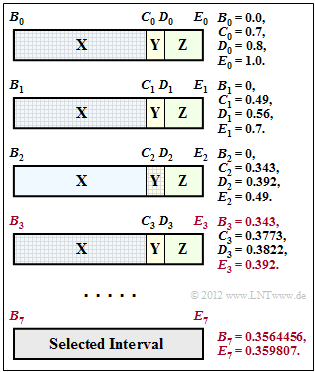Exercise 2.11Z: Arithmetic Coding once again
Here we consider arithmetic coding $(\rm AC)$. All necessary information about this type of entropy coding can be found in Exercise 2.11.
The graph is also the result of Exercise 2.11. The numerical values for coding steps 3 and 7 that are important for the current task are highlighted in colour:
- The interval for $N= 3$ $($symbol sequence $\rm XXY)$ starts at $B_3 = 0.343$ and goes up to $E_3 = 0.392$.
- The interval limits for $N= 7$ $($symbol sequence $\rm XXYXXXZ)$ are $B_7 = 0.3564456$ and $E_7 =0.359807$.
This task is only about assigning binary sequences to the selected intervals. Procedure:
- The interval $I$ is determined by the beginning $B$, the end $E$, the interval width ${\it \Delta} = E-B$ sowie die Intervallmitte $M = (B+E)/2$.
- The interval $I$ is characterised by the binary representation (with limited resolution) of any real number value $r \in I$. For example, one chooses $r \approx M$.
- The required number of bits results from the interval width according to the following equation (the open square brackets mean "round up"):
- $$N_{\rm Bit} = \left\lceil{\rm log_2} \hspace{0.15cm} 1/{\it \Delta} \right\rceil+1\hspace{0.05cm}. $$
For example, for $N_{\rm Bit} = 5$ the binary code 01001 stands for the following real-valued number $r$:
- $$r = 0 \cdot 2^{-1}+1 \cdot 2^{-2}+0 \cdot 2^{-3}+0 \cdot 2^{-4}+1 \cdot 2^{-5} = 0.28125 \hspace{0.05cm}. $$
Hints:
- The task belongs to the chapter Other source coding methods.
- In particular, reference is made to the page Arithmetic coding.
- Further information on the topic can also be found in this Wikipedia article.
Questions
Solution
- Die Intervallbreite ist somit ${\it \Delta}_3 = 0.049$ und damit gilt mit dem Logarithmus dualis:
- $$N_{\rm Bit} = {\rm log_2} \hspace{0.15cm} \left\lceil \frac{1}{0.049}\right\rceil+1\hspace{0.15cm}\underline{= 6} \hspace{0.05cm}.$$
(2) Das ausgewählte Intervall ergibt sich zu $I = \big[0.343, \ 0.392\big)$.
- Die Mitte liegt bei $M_3 = 0.3675$.
- Zur Bestimmung des arithmetischen Codes versuchen wir, die Intervallmitte durch eine Binärdarstellung möglichst gut zu erreichen.
- Da uns gerade kein entsprechendes Tool zur Lösung dieser Aufgabe zur Verfügung steht, gehen wir von folgenden Nebenrechnungen aus:
- $H_4 = 2^{-2} + 2^{-2} = 0.3125$ ⇒ gehört nicht zum Intervall $I$.
- $H_5 = H_4 +2^{-5} = 0.34375 \in I$ ⇒ Binärdarstellung: 0.01011 ⇒ Code: 01011.
- $H_6 = H_5 +2^{-6} = 0.359375 \in I$ ⇒ Binärdarstellung: 0.010111 ⇒ Code: 010111.
- $H_7 = H_6 +2^{-7} = 0.3671875 \in I$ ⇒ Binärdarstellung: 0.0101111 ⇒ Code: 0101111.
- $H_{12} = H_7 +2^{-12} = 0.3674316406 \in I$ ⇒ Binärdarstellung: 0.010111100001 ⇒ Code: 010111100001.
Der entsprechende 6 Bit–Code lautet somit $\rm AC =$ 010111 ⇒ Richtig ist der Lösungsvorschlag 2.
(3) Hier ergibt sich mit dem Beginn $B_7 = 0.3564456$ und dem Ende $E_7 = 0.359807$ die Intervallbreite ${\it \Delta}_7 = 0.0033614$ und damit
- $$N_{\rm Bit} = \left\lceil {\rm log_2} \hspace{0.15cm} \frac{1}{0.0033614} \right\rceil + 1\hspace{0.15cm} = \left\lceil {\rm log_2} \hspace{0.15cm} 297.5 \right\rceil + 1\hspace{0.15cm} \underline{= 11} \hspace{0.05cm}.$$
(4) Die Binärdarstellung des Codes 01011100001 ergibt
- $$2^{-2}+ 2^{-4}+ 2^{-5}+ 2^{-6}+ 2^{-11} = 0.3598632813 > E_7 \hspace{0.05cm}.$$
- Richtig ist also NEIN. Der gültige arithmetische Code ist $\rm AC =$ 01011011101, wegen
- $$2^{-2}+ 2^{-4}+ 2^{-5}+ 2^{-7}+ 2^{-8}+ 2^{-9}+ 2^{-11} =0.3579101563 \hspace{0.3cm} \Rightarrow \hspace{0.3cm} B_7 \le 0.3579101563 < E_7.$$
(5) Alle Aussagen sind richtig. Siehe auch:
- Bodden, E.; Clasen, M.; Kneis, J.: Algebraische Kodierung. Proseminar, Lehrstuhl für Informatik IV, RWTH Aachen, 2002.
